c7a7c786f8940c70a287bc924a03b83b.ppt
- Количество слайдов: 98
 Chapter 5 Thermochemistry The energy of chemical reactions How do you keep track of it? Where does it come from?
Chapter 5 Thermochemistry The energy of chemical reactions How do you keep track of it? Where does it come from?
 Energy • The ability to: • do work • transfer heat. Ø Work: Energy used to cause an object that has mass to move. Ø Heat: Energy used to cause the temperature of an object to rise.
Energy • The ability to: • do work • transfer heat. Ø Work: Energy used to cause an object that has mass to move. Ø Heat: Energy used to cause the temperature of an object to rise.
 Units of Energy • The SI unit of energy is the joule (J). kg m 2 1 J = 1 s 2 • An older, non-SI unit is still in widespread use: The calorie (cal). 1 cal = 4. 184 J Energy has units of (mass)(velocity)2 Remember kinetic energy was 1/2 mv 2
Units of Energy • The SI unit of energy is the joule (J). kg m 2 1 J = 1 s 2 • An older, non-SI unit is still in widespread use: The calorie (cal). 1 cal = 4. 184 J Energy has units of (mass)(velocity)2 Remember kinetic energy was 1/2 mv 2
 Work • Energy used to move an object over some distance. • w = F d, w = work, F = force d = distance over which the force is exerted. Note units: F = ma, mass(distance/s 2) W = F(d) = mass(distance 2/s 2) = mv 2
Work • Energy used to move an object over some distance. • w = F d, w = work, F = force d = distance over which the force is exerted. Note units: F = ma, mass(distance/s 2) W = F(d) = mass(distance 2/s 2) = mv 2
 Heat • Energy can also be transferred as heat. • Heat flows from warmer objects to cooler objects.
Heat • Energy can also be transferred as heat. • Heat flows from warmer objects to cooler objects.
 Kinetic Energy an object possesses by virtue of its motion. 1 KE = mv 2 2
Kinetic Energy an object possesses by virtue of its motion. 1 KE = mv 2 2
 Potential Energy an object possesses by virtue of its position or chemical composition. More potential E Less P. E. as bike goes down.
Potential Energy an object possesses by virtue of its position or chemical composition. More potential E Less P. E. as bike goes down.
 Transferal of Energy a) Add P. E. to a ball by lifting it to the top of the wall
Transferal of Energy a) Add P. E. to a ball by lifting it to the top of the wall
 Transferal of Energy a) Add P. E. to a ball by lifting it to the top of the wall b) As the ball falls, P. E ------> K. E. (1/2 mv 2)
Transferal of Energy a) Add P. E. to a ball by lifting it to the top of the wall b) As the ball falls, P. E ------> K. E. (1/2 mv 2)
 Transferal of Energy a) Add P. E. to a ball by lifting it to the top of the wall b) As the ball falls, P. E ------> K. E. (1/2 mv 2) Ball hits ground, K. E. =0, but E has to go somewhere. So 1. Ball gets squashed 2. Heat comes out.
Transferal of Energy a) Add P. E. to a ball by lifting it to the top of the wall b) As the ball falls, P. E ------> K. E. (1/2 mv 2) Ball hits ground, K. E. =0, but E has to go somewhere. So 1. Ball gets squashed 2. Heat comes out.
 Energy accounting • We must identify where different types of energy go. • Therefore, we must identify the places.
Energy accounting • We must identify where different types of energy go. • Therefore, we must identify the places.
 System and Surroundings • The system includes the molecules we want to study (here, the hydrogen and oxygen molecules). • The surroundings are everything else (here, the cylinder and piston).
System and Surroundings • The system includes the molecules we want to study (here, the hydrogen and oxygen molecules). • The surroundings are everything else (here, the cylinder and piston).
 First Law of Thermodynamics • Energy is conserved. • In other words, the total energy of the universe is a constant; ESystem = - Esurroundings
First Law of Thermodynamics • Energy is conserved. • In other words, the total energy of the universe is a constant; ESystem = - Esurroundings
 Internal Energy The internal energy of a system is the sum of all kinetic and potential energies of all components of the system; we call it E. Einternal, total= EKE + EPE + Eelectrons + Enuclei +…… Almost impossible to calculate total internal energy Instead we always look at the change in energy ( E).
Internal Energy The internal energy of a system is the sum of all kinetic and potential energies of all components of the system; we call it E. Einternal, total= EKE + EPE + Eelectrons + Enuclei +…… Almost impossible to calculate total internal energy Instead we always look at the change in energy ( E).
 Internal Energy By definition, the change in internal energy, E, is the final energy of the system minus the initial energy of the system: E = Efinal − Einitial
Internal Energy By definition, the change in internal energy, E, is the final energy of the system minus the initial energy of the system: E = Efinal − Einitial
 Changes in Internal Energy • If E > 0, Efinal > Einitial ØTherefore, the system absorbed energy from the surroundings. ØThis energy change is called endergonic.
Changes in Internal Energy • If E > 0, Efinal > Einitial ØTherefore, the system absorbed energy from the surroundings. ØThis energy change is called endergonic.
 Changes in Internal Energy • If E < 0, Efinal < Einitial ØTherefore, the system released energy to the surroundings. ØThis energy change is called exergonic.
Changes in Internal Energy • If E < 0, Efinal < Einitial ØTherefore, the system released energy to the surroundings. ØThis energy change is called exergonic.
 Changes in Internal Energy • When energy is exchanged between the system and the surroundings, it is exchanged as either heat (q) or work (w). • That is, E = q + w.
Changes in Internal Energy • When energy is exchanged between the system and the surroundings, it is exchanged as either heat (q) or work (w). • That is, E = q + w.
 E, q, w, and Their Signs -q Surroundings suck heat out of water. +q hot plate adds heat to water
E, q, w, and Their Signs -q Surroundings suck heat out of water. +q hot plate adds heat to water
 Sign of work block pushes truck down does work on truck wblockwtruck+ Truck pushes block up. Does work on block wtruckwblock+
Sign of work block pushes truck down does work on truck wblockwtruck+ Truck pushes block up. Does work on block wtruckwblock+
 Exchange of Heat between System and Surroundings • When heat is absorbed by the system from the surroundings, the process is endothermic.
Exchange of Heat between System and Surroundings • When heat is absorbed by the system from the surroundings, the process is endothermic.
 Exchange of Heat between System and Surroundings • Heat absorbed by system from surroundings, is endothermic. • Heat released by system to surroundings, the is exothermic.
Exchange of Heat between System and Surroundings • Heat absorbed by system from surroundings, is endothermic. • Heat released by system to surroundings, the is exothermic.
 State Functions Total internal energy of a system: K. E. + Eelectrons + Enucleus + P. E. total virtually impossible to measure/calculate
State Functions Total internal energy of a system: K. E. + Eelectrons + Enucleus + P. E. total virtually impossible to measure/calculate
 State Functions • However, we do know that the internal energy of a system is independent of the path by which the system achieved that state. Ø In the system below, the water could have reached room temperature from either direction.
State Functions • However, we do know that the internal energy of a system is independent of the path by which the system achieved that state. Ø In the system below, the water could have reached room temperature from either direction.
 State Functions • Therefore, internal energy is a state function. • because it’s PATH INDEPENDENT • And so, E depends only on Einitial and Efinal.
State Functions • Therefore, internal energy is a state function. • because it’s PATH INDEPENDENT • And so, E depends only on Einitial and Efinal.
 State Functions • However, q and w are not state functions. • Whether the battery is shorted out or is discharged by running the fan, its E is the same. Ø But q and w are different in the two cases.
State Functions • However, q and w are not state functions. • Whether the battery is shorted out or is discharged by running the fan, its E is the same. Ø But q and w are different in the two cases.
 Work process in an open container (chemical reaction in a beaker) w? (can there be any work)? Yes, evolving gases could push on the surroundings.
Work process in an open container (chemical reaction in a beaker) w? (can there be any work)? Yes, evolving gases could push on the surroundings.
 Catch the work, do the same process in a cylinder Process evolves gas, pushes on piston, work done on piston
Catch the work, do the same process in a cylinder Process evolves gas, pushes on piston, work done on piston
 Catch the work, do the same process in a cylinder w = F*d, F = P*A, d= h w = -P*A h= -P V Negative because an increase in Volume means that the system is doing work on the surroundings. E = q + w = q - P V q. P = E + P V
Catch the work, do the same process in a cylinder w = F*d, F = P*A, d= h w = -P*A h= -P V Negative because an increase in Volume means that the system is doing work on the surroundings. E = q + w = q - P V q. P = E + P V
 Example • Gas inside cylinder with electric heater. • Add 100 j heat with heater. • 1. Piston can go up and down • 2. Piston stuck. • a. What happens to T in each case? • b. What about q and w for each case? • c. What about E in each case?
Example • Gas inside cylinder with electric heater. • Add 100 j heat with heater. • 1. Piston can go up and down • 2. Piston stuck. • a. What happens to T in each case? • b. What about q and w for each case? • c. What about E in each case?
 • • Gas inside cyclinder with electric heater. Add 100 j heat with heater. 1. Piston can go up and down 2. Piston stuck. a. What happens to T in each case? b. What about q and w for each case? c. What about E in each case? Example a. 1. Piston goes up, some E goes to expand gas, do work. T goes up less a. 2 T goes up more, all E goes to q. b. 1. both q and w positive b. 2. w 0, q larger c. E the same & + in each case
• • Gas inside cyclinder with electric heater. Add 100 j heat with heater. 1. Piston can go up and down 2. Piston stuck. a. What happens to T in each case? b. What about q and w for each case? c. What about E in each case? Example a. 1. Piston goes up, some E goes to expand gas, do work. T goes up less a. 2 T goes up more, all E goes to q. b. 1. both q and w positive b. 2. w 0, q larger c. E the same & + in each case
 Work Now we can measure the work: w = −P V Zn + 2 HCl -----> H 2(g) + Zn. Cl 2
Work Now we can measure the work: w = −P V Zn + 2 HCl -----> H 2(g) + Zn. Cl 2
 Work Zn + 2 HCl -----> H 2(g) + Zn. Cl 2 I mole of Zn reacts. How much work is done (P = 1 atm, density of H 2 = 0. 0823 g/L)? 1 mole of H 2 is produced.
Work Zn + 2 HCl -----> H 2(g) + Zn. Cl 2 I mole of Zn reacts. How much work is done (P = 1 atm, density of H 2 = 0. 0823 g/L)? 1 mole of H 2 is produced.
 Work I mole of Zn reacts. How much work is done (P = 1 atm, density of H 2 = 0. 0823 g/L)? 1 mole of H 2 is produced. Zn + 2 HCl -----> H 2(g) + Zn. Cl 2 1 mol 1 mol 2. 014 g/mol 2. 014 g d=m/V V=m/d V = 2. 014 g/0. 0823 g/L = 24. 47 L W = -P V = 1 atm(24. 47 L) = -24. 47 L(atm)
Work I mole of Zn reacts. How much work is done (P = 1 atm, density of H 2 = 0. 0823 g/L)? 1 mole of H 2 is produced. Zn + 2 HCl -----> H 2(g) + Zn. Cl 2 1 mol 1 mol 2. 014 g/mol 2. 014 g d=m/V V=m/d V = 2. 014 g/0. 0823 g/L = 24. 47 L W = -P V = 1 atm(24. 47 L) = -24. 47 L(atm)
 Enthalpy(H) H = E + PV This is the definition of Enthalpy for any process Buy why do we care?
Enthalpy(H) H = E + PV This is the definition of Enthalpy for any process Buy why do we care?
 Enthalpy H = E + PV • at constant pressure, H, is = change in thermodynamics) H = (E + PV) • This can be written (if P constant) H = E + P V
Enthalpy H = E + PV • at constant pressure, H, is = change in thermodynamics) H = (E + PV) • This can be written (if P constant) H = E + P V
 Enthalpy • Since E = q + w and w = −P V (P const. ) substitute these into the enthalpy expression: H = E + P V H = (q+w) − w H = q • Note: true at constant pressure • q is a state function at const P & only PV work.
Enthalpy • Since E = q + w and w = −P V (P const. ) substitute these into the enthalpy expression: H = E + P V H = (q+w) − w H = q • Note: true at constant pressure • q is a state function at const P & only PV work.
 H = E + PV • Because: • If pressure is constant (like open to atmosphere, i. e. most things) and w = PV. heat flow (q) = H (enthalpy) of system. And: H is a state function, so q is also. but only in the right conditions
H = E + PV • Because: • If pressure is constant (like open to atmosphere, i. e. most things) and w = PV. heat flow (q) = H (enthalpy) of system. And: H is a state function, so q is also. but only in the right conditions
 Endothermic vs. Exothermic • A process is endothermic when H is positive.
Endothermic vs. Exothermic • A process is endothermic when H is positive.
 Endothermicity and Exothermicity • A process is endothermic when H is positive. • A process is exothermic when H is negative.
Endothermicity and Exothermicity • A process is endothermic when H is positive. • A process is exothermic when H is negative.
 Enthalpies of Reaction The change in enthalpy, H, is the enthalpy of the products minus the enthalpy of the reactants: H = Hproducts − Hreactants
Enthalpies of Reaction The change in enthalpy, H, is the enthalpy of the products minus the enthalpy of the reactants: H = Hproducts − Hreactants
 Enthalpies of Reaction This quantity, H, is called the enthalpy of reaction, or the heat of reaction.
Enthalpies of Reaction This quantity, H, is called the enthalpy of reaction, or the heat of reaction.
 Reaction Enthalpy summary 1. Enthalpy is an extensive property. 2. H for a reaction in the forward direction is equal in size, but opposite in sign, to H for the reverse reaction. 3. H for a reaction depends on the state of the products and the state of the reactants.
Reaction Enthalpy summary 1. Enthalpy is an extensive property. 2. H for a reaction in the forward direction is equal in size, but opposite in sign, to H for the reverse reaction. 3. H for a reaction depends on the state of the products and the state of the reactants.
 Enthalpy of reaction example Consider the reaction: 2 KCl. O 3 -------> 2 KCl + 3 O 2 H = -89. 4 k. J/mol a. What is the enthalpy change formation of 0. 855 moles of O 2?
Enthalpy of reaction example Consider the reaction: 2 KCl. O 3 -------> 2 KCl + 3 O 2 H = -89. 4 k. J/mol a. What is the enthalpy change formation of 0. 855 moles of O 2?
 Enthalpy of reaction example Consider the reaction: 2 KCl. O 3 -------> 2 KCl + 3 O 2 H = -89. 4 k. J/mol a. What is the enthalpy change formation of 0. 855 moles of O 2? 2 KCl. O 3 -------> 2 KCl + 3 O 2 0. 855 mol H = -89. 4 k. J/3 mol O 2(. 855 mol O 2) = -25. 5 k. J
Enthalpy of reaction example Consider the reaction: 2 KCl. O 3 -------> 2 KCl + 3 O 2 H = -89. 4 k. J/mol a. What is the enthalpy change formation of 0. 855 moles of O 2? 2 KCl. O 3 -------> 2 KCl + 3 O 2 0. 855 mol H = -89. 4 k. J/3 mol O 2(. 855 mol O 2) = -25. 5 k. J
 Calorimetry Since we cannot know the exact enthalpy of the reactants and products, we measure H through calorimetry, the measurement of heat flow.
Calorimetry Since we cannot know the exact enthalpy of the reactants and products, we measure H through calorimetry, the measurement of heat flow.
 Heat Capacity and Specific Heat • heat capacity: amount of E required to raise the temperature of a substance by 1 K • specific heat: amount of E required to raise the temperature of 1 g of a substance by 1 K.
Heat Capacity and Specific Heat • heat capacity: amount of E required to raise the temperature of a substance by 1 K • specific heat: amount of E required to raise the temperature of 1 g of a substance by 1 K.
 Heat Capacity and Specific Heat Specific heat is: heat transferred Specific heat = mass temperature change q s= m T sm T = q
Heat Capacity and Specific Heat Specific heat is: heat transferred Specific heat = mass temperature change q s= m T sm T = q
 Constant Pressure Calorimetry indirectly measure the heat change for the system by measuring the heat change for the water in the calorimeter.
Constant Pressure Calorimetry indirectly measure the heat change for the system by measuring the heat change for the water in the calorimeter.
 Constant Pressure Calorimetry Because the specific heat for water is well known (4. 184 J/g-K), we can measure H for the reaction with this equation: q = m s T m = mass s = specific heat
Constant Pressure Calorimetry Because the specific heat for water is well known (4. 184 J/g-K), we can measure H for the reaction with this equation: q = m s T m = mass s = specific heat
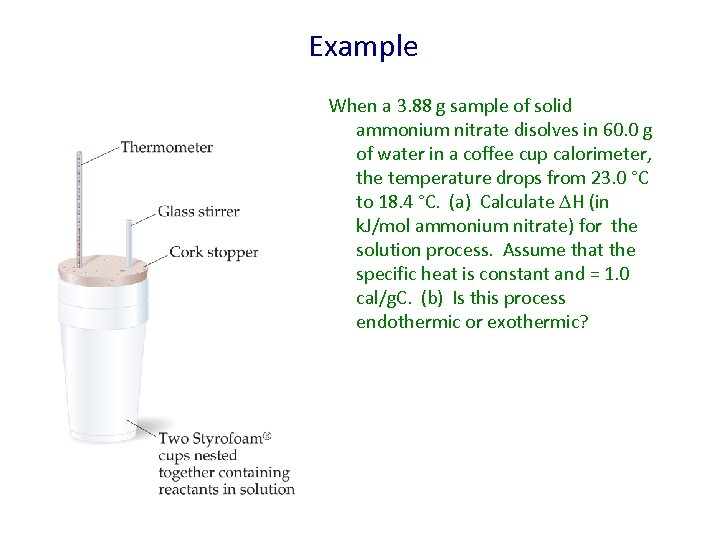 Example When a 3. 88 g sample of solid ammonium nitrate disolves in 60. 0 g of water in a coffee cup calorimeter, the temperature drops from 23. 0 °C to 18. 4 °C. (a) Calculate H (in k. J/mol ammonium nitrate) for the solution process. Assume that the specific heat is constant and = 1. 0 cal/g. C. (b) Is this process endothermic or exothermic?
Example When a 3. 88 g sample of solid ammonium nitrate disolves in 60. 0 g of water in a coffee cup calorimeter, the temperature drops from 23. 0 °C to 18. 4 °C. (a) Calculate H (in k. J/mol ammonium nitrate) for the solution process. Assume that the specific heat is constant and = 1. 0 cal/g. C. (b) Is this process endothermic or exothermic?
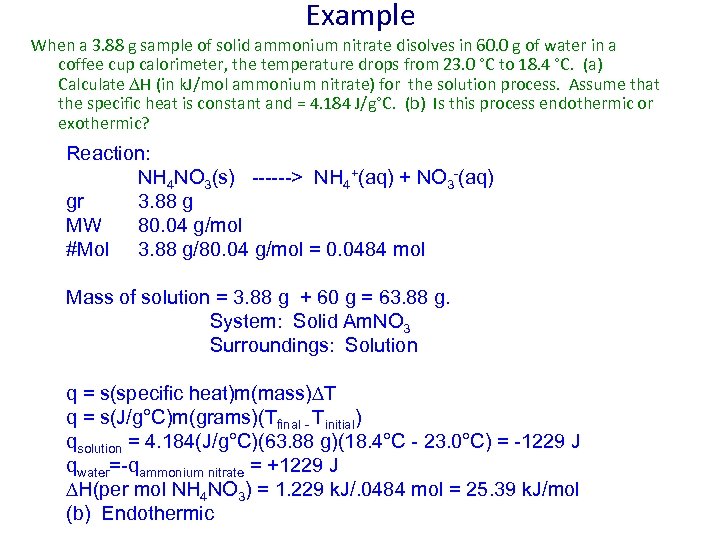 Example When a 3. 88 g sample of solid ammonium nitrate disolves in 60. 0 g of water in a coffee cup calorimeter, the temperature drops from 23. 0 °C to 18. 4 °C. (a) Calculate H (in k. J/mol ammonium nitrate) for the solution process. Assume that the specific heat is constant and = 4. 184 J/g°C. (b) Is this process endothermic or exothermic? Reaction: NH 4 NO 3(s) ------> NH 4+(aq) + NO 3 -(aq) gr 3. 88 g MW 80. 04 g/mol #Mol 3. 88 g/80. 04 g/mol = 0. 0484 mol Mass of solution = 3. 88 g + 60 g = 63. 88 g. System: Solid Am. NO 3 Surroundings: Solution q = s(specific heat)m(mass) T q = s(J/g°C)m(grams)(Tfinal - Tinitial) qsolution = 4. 184(J/g°C)(63. 88 g)(18. 4°C - 23. 0°C) = -1229 J qwater=-qammonium nitrate = +1229 J H(per mol NH 4 NO 3) = 1. 229 k. J/. 0484 mol = 25. 39 k. J/mol (b) Endothermic
Example When a 3. 88 g sample of solid ammonium nitrate disolves in 60. 0 g of water in a coffee cup calorimeter, the temperature drops from 23. 0 °C to 18. 4 °C. (a) Calculate H (in k. J/mol ammonium nitrate) for the solution process. Assume that the specific heat is constant and = 4. 184 J/g°C. (b) Is this process endothermic or exothermic? Reaction: NH 4 NO 3(s) ------> NH 4+(aq) + NO 3 -(aq) gr 3. 88 g MW 80. 04 g/mol #Mol 3. 88 g/80. 04 g/mol = 0. 0484 mol Mass of solution = 3. 88 g + 60 g = 63. 88 g. System: Solid Am. NO 3 Surroundings: Solution q = s(specific heat)m(mass) T q = s(J/g°C)m(grams)(Tfinal - Tinitial) qsolution = 4. 184(J/g°C)(63. 88 g)(18. 4°C - 23. 0°C) = -1229 J qwater=-qammonium nitrate = +1229 J H(per mol NH 4 NO 3) = 1. 229 k. J/. 0484 mol = 25. 39 k. J/mol (b) Endothermic
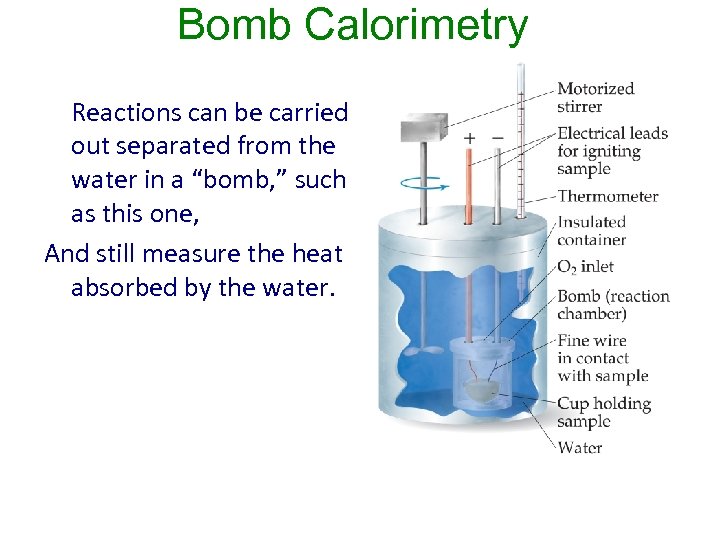 Bomb Calorimetry Reactions can be carried out separated from the water in a “bomb, ” such as this one, And still measure the heat absorbed by the water.
Bomb Calorimetry Reactions can be carried out separated from the water in a “bomb, ” such as this one, And still measure the heat absorbed by the water.
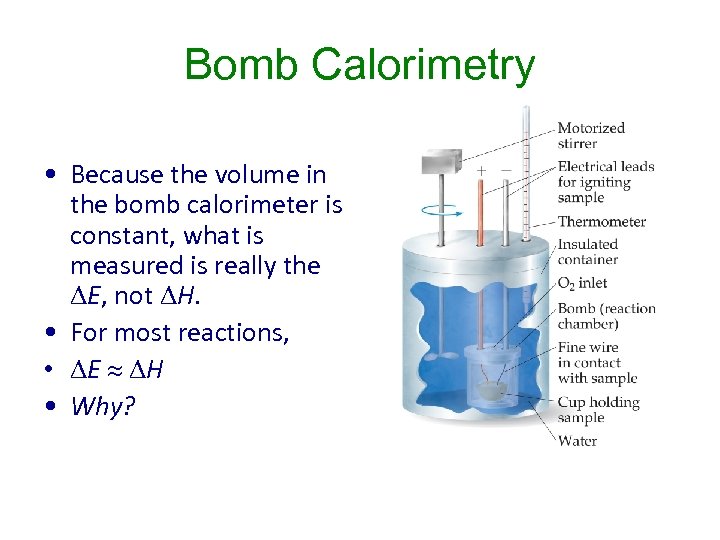 Bomb Calorimetry • Because the volume in the bomb calorimeter is constant, what is measured is really the E, not H. • For most reactions, • E H • Why?
Bomb Calorimetry • Because the volume in the bomb calorimeter is constant, what is measured is really the E, not H. • For most reactions, • E H • Why?
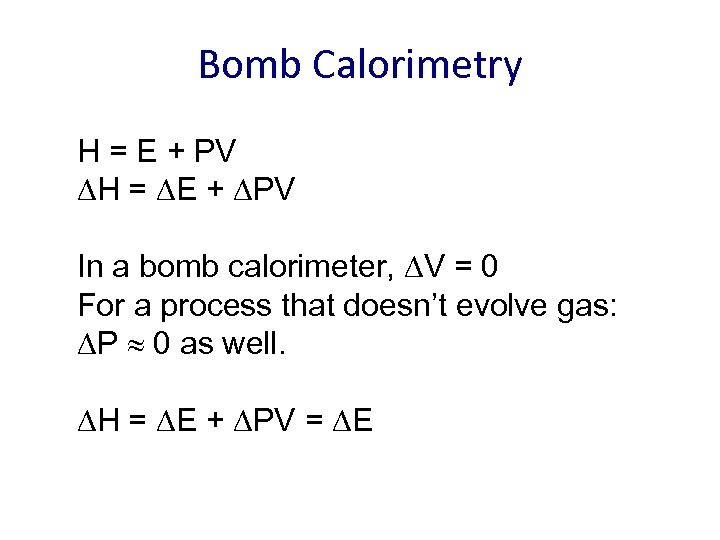 Bomb Calorimetry H = E + PV In a bomb calorimeter, V = 0 For a process that doesn’t evolve gas: P 0 as well. H = E + PV = E
Bomb Calorimetry H = E + PV In a bomb calorimeter, V = 0 For a process that doesn’t evolve gas: P 0 as well. H = E + PV = E
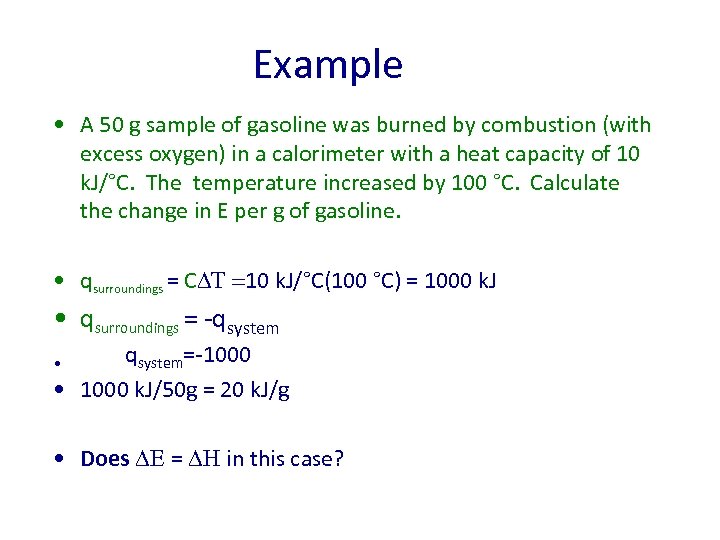 Example • A 50 g sample of gasoline was burned by combustion (with excess oxygen) in a calorimeter with a heat capacity of 10 k. J/°C. The temperature increased by 100 °C. Calculate the change in E per g of gasoline. • qsurroundings = C T =10 k. J/°C(100 °C) = 1000 k. J • qsurroundings = -qsystem=-1000 • 1000 k. J/50 g = 20 k. J/g • • Does E = H in this case?
Example • A 50 g sample of gasoline was burned by combustion (with excess oxygen) in a calorimeter with a heat capacity of 10 k. J/°C. The temperature increased by 100 °C. Calculate the change in E per g of gasoline. • qsurroundings = C T =10 k. J/°C(100 °C) = 1000 k. J • qsurroundings = -qsystem=-1000 • 1000 k. J/50 g = 20 k. J/g • • Does E = H in this case?
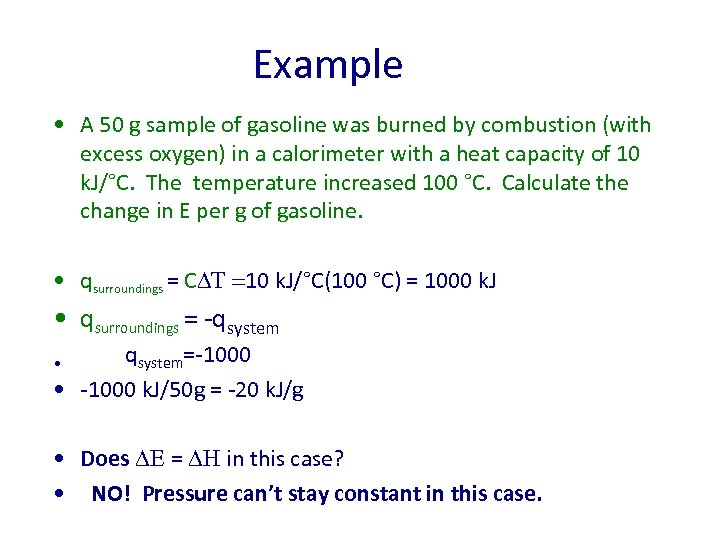 Example • A 50 g sample of gasoline was burned by combustion (with excess oxygen) in a calorimeter with a heat capacity of 10 k. J/°C. The temperature increased 100 °C. Calculate the change in E per g of gasoline. • qsurroundings = C T =10 k. J/°C(100 °C) = 1000 k. J • qsurroundings = -qsystem=-1000 • -1000 k. J/50 g = -20 k. J/g • • Does E = H in this case? • NO! Pressure can’t stay constant in this case.
Example • A 50 g sample of gasoline was burned by combustion (with excess oxygen) in a calorimeter with a heat capacity of 10 k. J/°C. The temperature increased 100 °C. Calculate the change in E per g of gasoline. • qsurroundings = C T =10 k. J/°C(100 °C) = 1000 k. J • qsurroundings = -qsystem=-1000 • -1000 k. J/50 g = -20 k. J/g • • Does E = H in this case? • NO! Pressure can’t stay constant in this case.
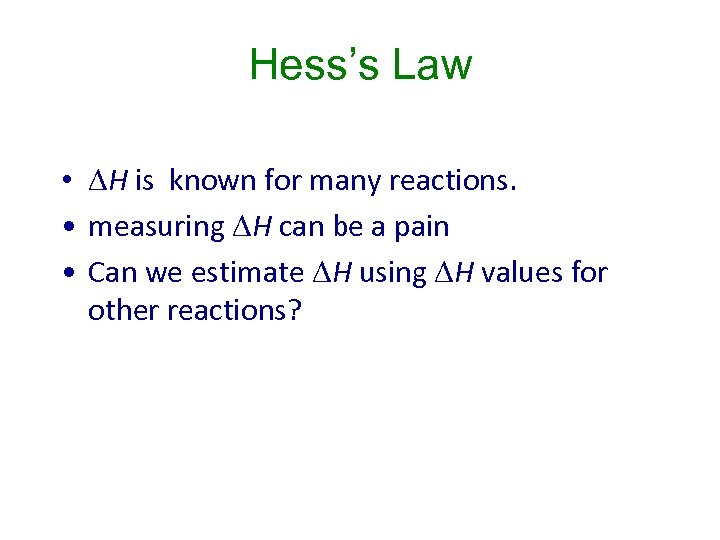 Hess’s Law • H is known for many reactions. • measuring H can be a pain • Can we estimate H using H values for other reactions?
Hess’s Law • H is known for many reactions. • measuring H can be a pain • Can we estimate H using H values for other reactions?
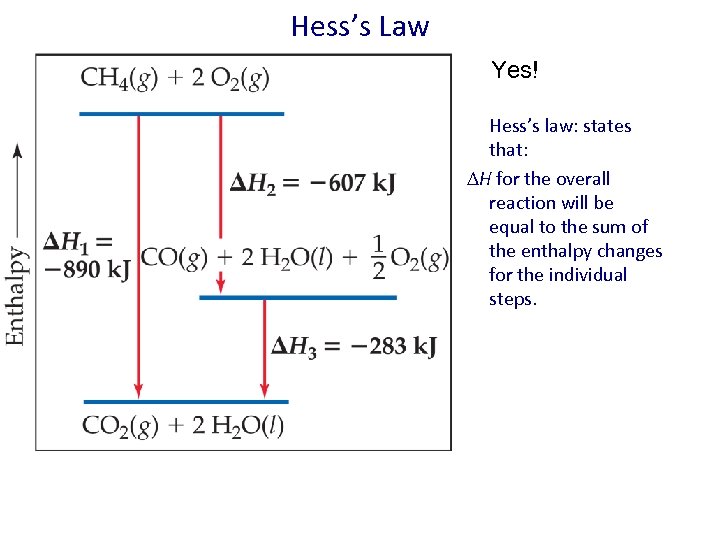 Hess’s Law Yes! Hess’s law: states that: H for the overall reaction will be equal to the sum of the enthalpy changes for the individual steps.
Hess’s Law Yes! Hess’s law: states that: H for the overall reaction will be equal to the sum of the enthalpy changes for the individual steps.
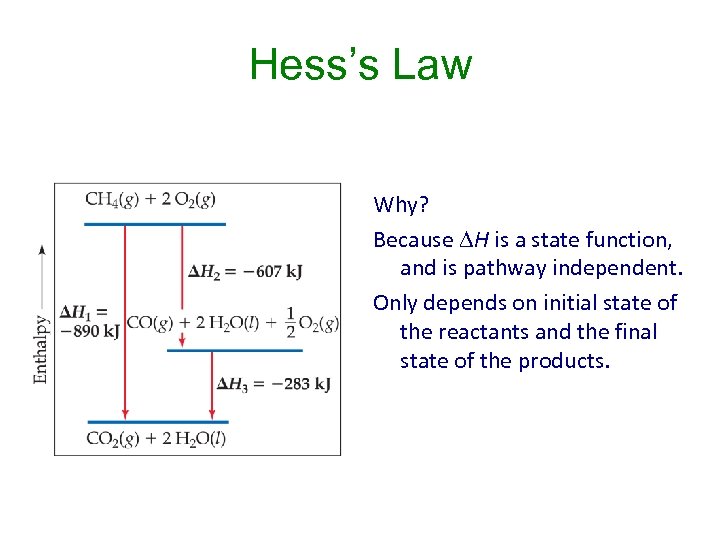 Hess’s Law Why? Because H is a state function, and is pathway independent. Only depends on initial state of the reactants and the final state of the products.
Hess’s Law Why? Because H is a state function, and is pathway independent. Only depends on initial state of the reactants and the final state of the products.
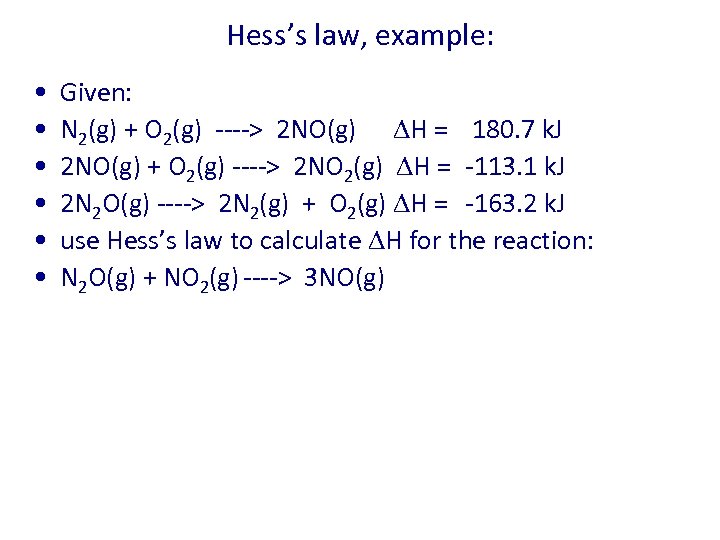 Hess’s law, example: • • • Given: N 2(g) + O 2(g) ----> 2 NO(g) H = 180. 7 k. J 2 NO(g) + O 2(g) ----> 2 NO 2(g) H = -113. 1 k. J 2 N 2 O(g) ----> 2 N 2(g) + O 2(g) H = -163. 2 k. J use Hess’s law to calculate H for the reaction: N 2 O(g) + NO 2(g) ----> 3 NO(g)
Hess’s law, example: • • • Given: N 2(g) + O 2(g) ----> 2 NO(g) H = 180. 7 k. J 2 NO(g) + O 2(g) ----> 2 NO 2(g) H = -113. 1 k. J 2 N 2 O(g) ----> 2 N 2(g) + O 2(g) H = -163. 2 k. J use Hess’s law to calculate H for the reaction: N 2 O(g) + NO 2(g) ----> 3 NO(g)
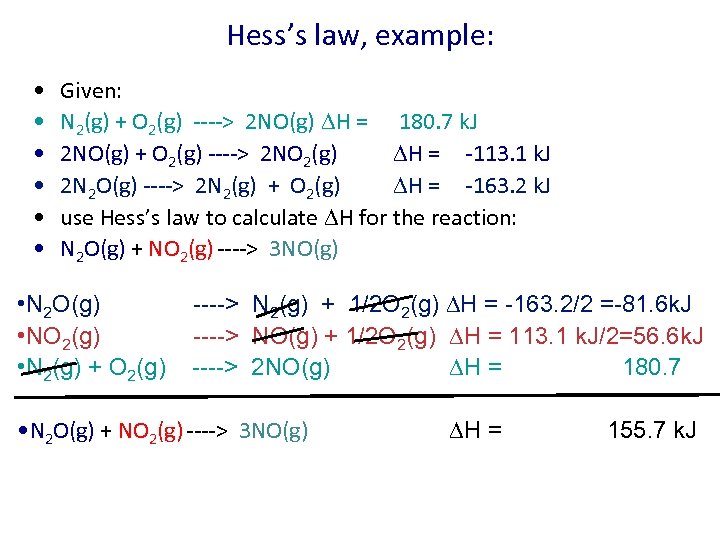 Hess’s law, example: • • • Given: N 2(g) + O 2(g) ----> 2 NO(g) H = 180. 7 k. J 2 NO(g) + O 2(g) ----> 2 NO 2(g) H = -113. 1 k. J 2 N 2 O(g) ----> 2 N 2(g) + O 2(g) H = -163. 2 k. J use Hess’s law to calculate H for the reaction: N 2 O(g) + NO 2(g) ----> 3 NO(g) • N 2 O(g) • NO 2(g) • N 2(g) + O 2(g) ----> N 2(g) + 1/2 O 2(g) H = -163. 2/2 =-81. 6 k. J ----> NO(g) + 1/2 O 2(g) H = 113. 1 k. J/2=56. 6 k. J ----> 2 NO(g) H = 180. 7 • N 2 O(g) + NO 2(g) ----> 3 NO(g) H = 155. 7 k. J
Hess’s law, example: • • • Given: N 2(g) + O 2(g) ----> 2 NO(g) H = 180. 7 k. J 2 NO(g) + O 2(g) ----> 2 NO 2(g) H = -113. 1 k. J 2 N 2 O(g) ----> 2 N 2(g) + O 2(g) H = -163. 2 k. J use Hess’s law to calculate H for the reaction: N 2 O(g) + NO 2(g) ----> 3 NO(g) • N 2 O(g) • NO 2(g) • N 2(g) + O 2(g) ----> N 2(g) + 1/2 O 2(g) H = -163. 2/2 =-81. 6 k. J ----> NO(g) + 1/2 O 2(g) H = 113. 1 k. J/2=56. 6 k. J ----> 2 NO(g) H = 180. 7 • N 2 O(g) + NO 2(g) ----> 3 NO(g) H = 155. 7 k. J
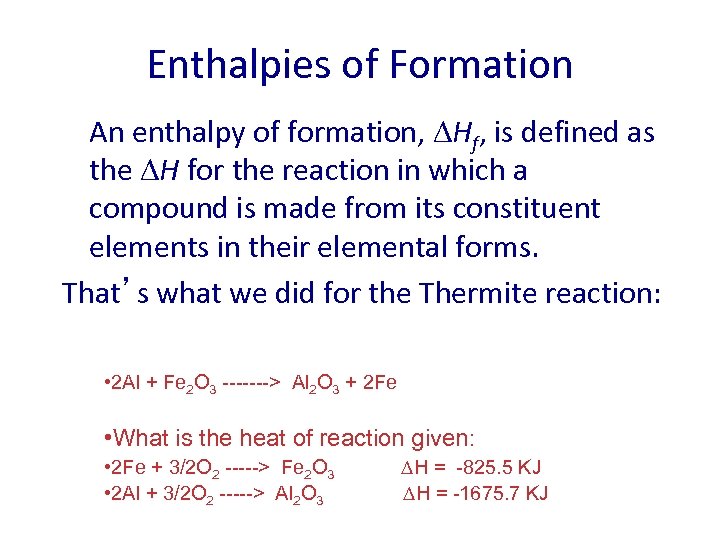 Enthalpies of Formation An enthalpy of formation, Hf, is defined as the H for the reaction in which a compound is made from its constituent elements in their elemental forms. That’s what we did for the Thermite reaction: • 2 Al + Fe 2 O 3 -------> Al 2 O 3 + 2 Fe • What is the heat of reaction given: • 2 Fe + 3/2 O 2 -----> Fe 2 O 3 • 2 Al + 3/2 O 2 -----> Al 2 O 3 H = -825. 5 KJ H = -1675. 7 KJ
Enthalpies of Formation An enthalpy of formation, Hf, is defined as the H for the reaction in which a compound is made from its constituent elements in their elemental forms. That’s what we did for the Thermite reaction: • 2 Al + Fe 2 O 3 -------> Al 2 O 3 + 2 Fe • What is the heat of reaction given: • 2 Fe + 3/2 O 2 -----> Fe 2 O 3 • 2 Al + 3/2 O 2 -----> Al 2 O 3 H = -825. 5 KJ H = -1675. 7 KJ
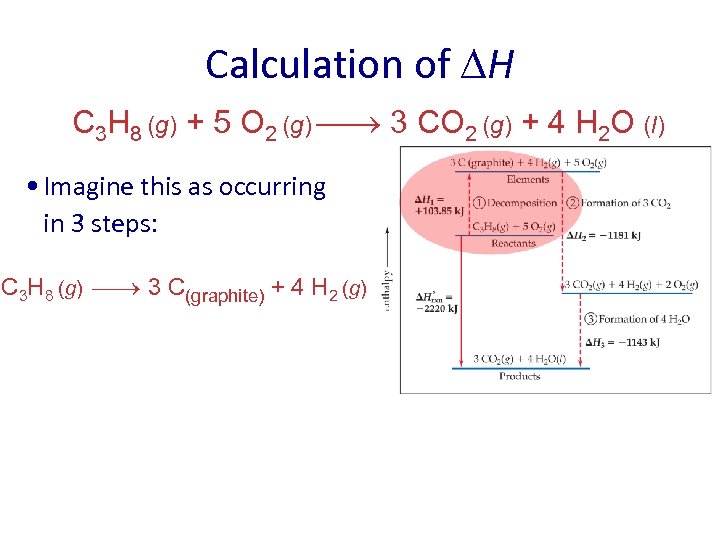 Calculation of H C 3 H 8 (g) + 5 O 2 (g) 3 CO 2 (g) + 4 H 2 O (l) • Imagine this as occurring in 3 steps: C 3 H 8 (g) 3 C(graphite) + 4 H 2 (g) 3 C(graphite) + 3 O 2 (g) 3 CO 2 (g) 4 H 2 (g) + 2 O 2 (g) 4 H 2 O (l)
Calculation of H C 3 H 8 (g) + 5 O 2 (g) 3 CO 2 (g) + 4 H 2 O (l) • Imagine this as occurring in 3 steps: C 3 H 8 (g) 3 C(graphite) + 4 H 2 (g) 3 C(graphite) + 3 O 2 (g) 3 CO 2 (g) 4 H 2 (g) + 2 O 2 (g) 4 H 2 O (l)
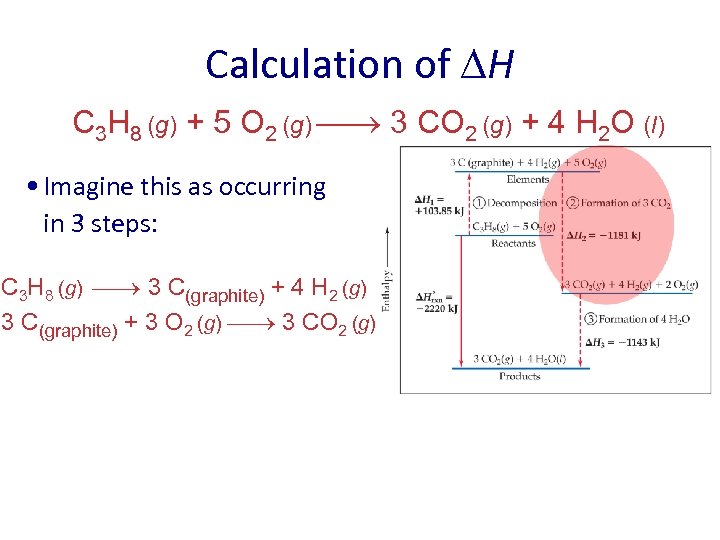 Calculation of H C 3 H 8 (g) + 5 O 2 (g) 3 CO 2 (g) + 4 H 2 O (l) • Imagine this as occurring in 3 steps: C 3 H 8 (g) 3 C(graphite) + 4 H 2 (g) 3 C(graphite) + 3 O 2 (g) 3 CO 2 (g) 4 H 2 (g) + 2 O 2 (g) 4 H 2 O (l)
Calculation of H C 3 H 8 (g) + 5 O 2 (g) 3 CO 2 (g) + 4 H 2 O (l) • Imagine this as occurring in 3 steps: C 3 H 8 (g) 3 C(graphite) + 4 H 2 (g) 3 C(graphite) + 3 O 2 (g) 3 CO 2 (g) 4 H 2 (g) + 2 O 2 (g) 4 H 2 O (l)
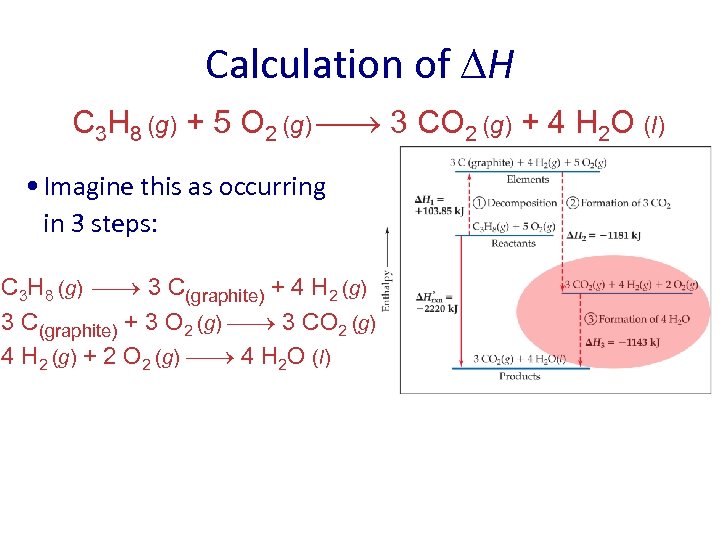 Calculation of H C 3 H 8 (g) + 5 O 2 (g) 3 CO 2 (g) + 4 H 2 O (l) • Imagine this as occurring in 3 steps: C 3 H 8 (g) 3 C(graphite) + 4 H 2 (g) 3 C(graphite) + 3 O 2 (g) 3 CO 2 (g) 4 H 2 (g) + 2 O 2 (g) 4 H 2 O (l)
Calculation of H C 3 H 8 (g) + 5 O 2 (g) 3 CO 2 (g) + 4 H 2 O (l) • Imagine this as occurring in 3 steps: C 3 H 8 (g) 3 C(graphite) + 4 H 2 (g) 3 C(graphite) + 3 O 2 (g) 3 CO 2 (g) 4 H 2 (g) + 2 O 2 (g) 4 H 2 O (l)
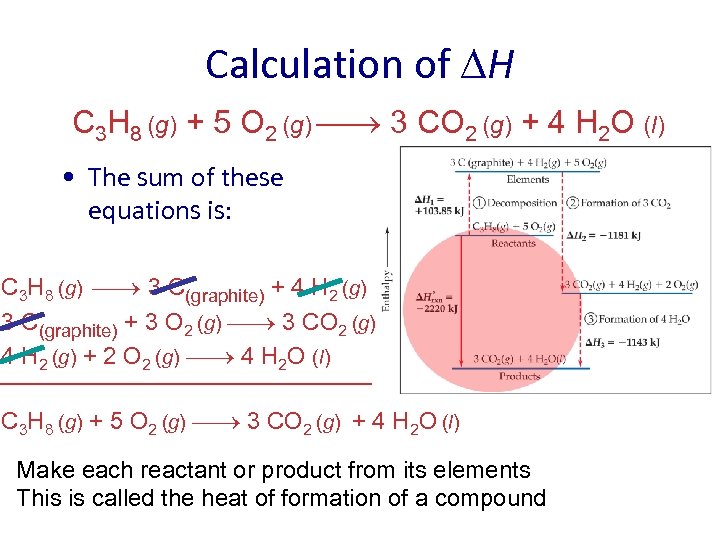 Calculation of H C 3 H 8 (g) + 5 O 2 (g) 3 CO 2 (g) + 4 H 2 O (l) • The sum of these equations is: C 3 H 8 (g) 3 C(graphite) + 4 H 2 (g) 3 C(graphite) + 3 O 2 (g) 3 CO 2 (g) 4 H 2 (g) + 2 O 2 (g) 4 H 2 O (l) C 3 H 8 (g) + 5 O 2 (g) 3 CO 2 (g) + 4 H 2 O (l) Make each reactant or product from its elements This is called the heat of formation of a compound
Calculation of H C 3 H 8 (g) + 5 O 2 (g) 3 CO 2 (g) + 4 H 2 O (l) • The sum of these equations is: C 3 H 8 (g) 3 C(graphite) + 4 H 2 (g) 3 C(graphite) + 3 O 2 (g) 3 CO 2 (g) 4 H 2 (g) + 2 O 2 (g) 4 H 2 O (l) C 3 H 8 (g) + 5 O 2 (g) 3 CO 2 (g) + 4 H 2 O (l) Make each reactant or product from its elements This is called the heat of formation of a compound
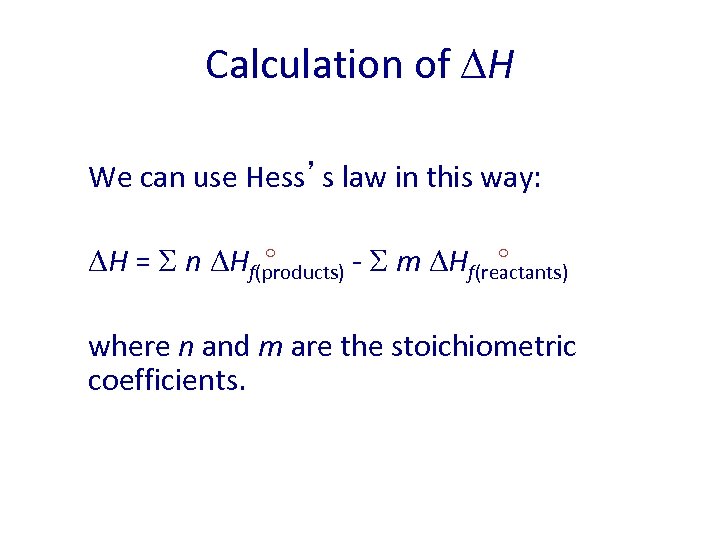 Calculation of H We can use Hess’s law in this way: H = n Hf(products) - m Hf(reactants) where n and m are the stoichiometric coefficients.
Calculation of H We can use Hess’s law in this way: H = n Hf(products) - m Hf(reactants) where n and m are the stoichiometric coefficients.
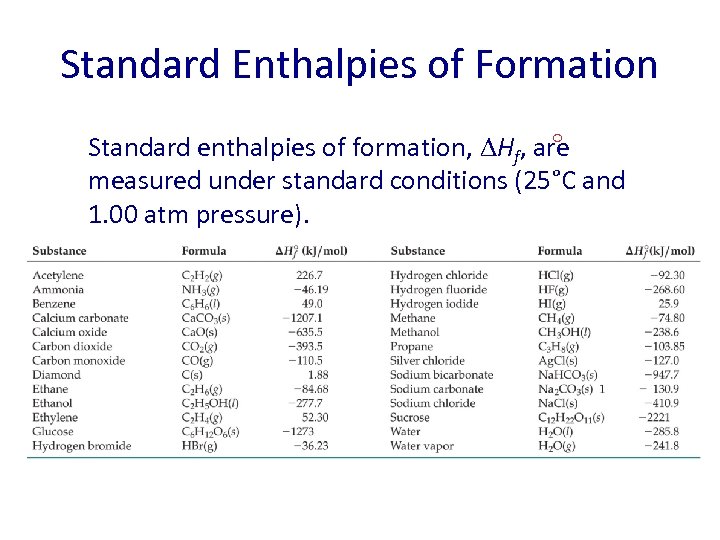 Standard Enthalpies of Formation Standard enthalpies of formation, Hf, are measured under standard conditions (25°C and 1. 00 atm pressure).
Standard Enthalpies of Formation Standard enthalpies of formation, Hf, are measured under standard conditions (25°C and 1. 00 atm pressure).
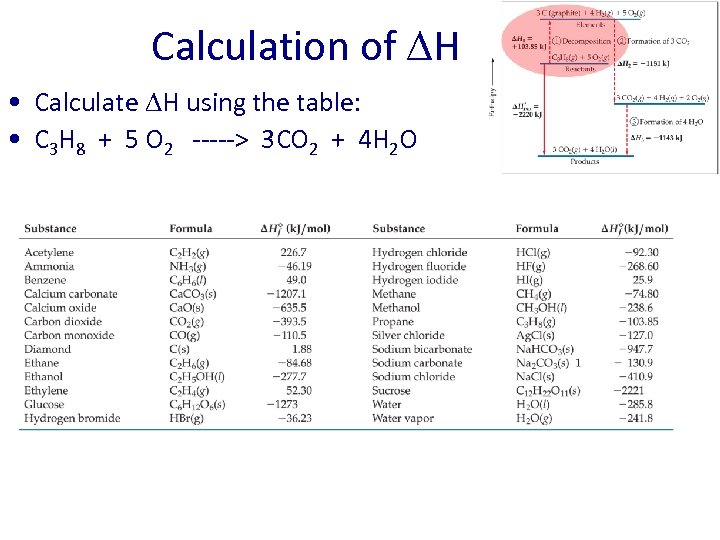 Calculation of H • Calculate H using the table: • C 3 H 8 + 5 O 2 -----> 3 CO 2 + 4 H 2 O
Calculation of H • Calculate H using the table: • C 3 H 8 + 5 O 2 -----> 3 CO 2 + 4 H 2 O
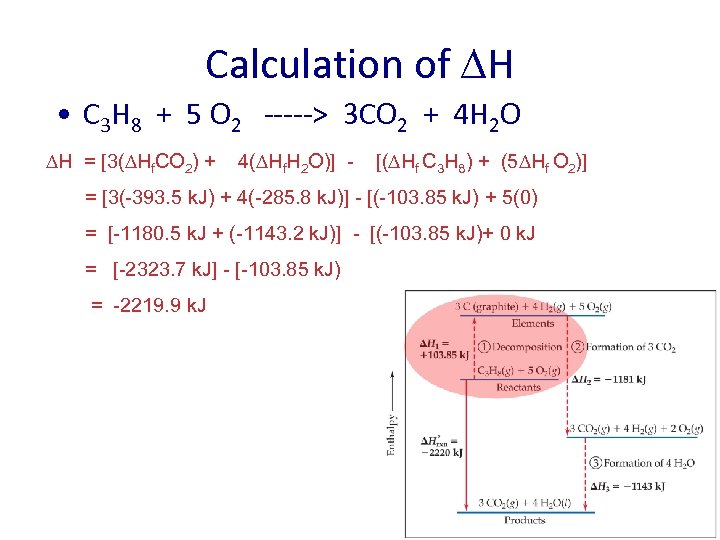 Calculation of H • C 3 H 8 + 5 O 2 -----> 3 CO 2 + 4 H 2 O H = [3( Hf. CO 2) + 4( Hf. H 2 O)] - [( Hf C 3 H 8) + (5 Hf O 2)] = [3(-393. 5 k. J) + 4(-285. 8 k. J)] - [(-103. 85 k. J) + 5(0) = [-1180. 5 k. J + (-1143. 2 k. J)] - [(-103. 85 k. J)+ 0 k. J = [-2323. 7 k. J] - [-103. 85 k. J) = -2219. 9 k. J
Calculation of H • C 3 H 8 + 5 O 2 -----> 3 CO 2 + 4 H 2 O H = [3( Hf. CO 2) + 4( Hf. H 2 O)] - [( Hf C 3 H 8) + (5 Hf O 2)] = [3(-393. 5 k. J) + 4(-285. 8 k. J)] - [(-103. 85 k. J) + 5(0) = [-1180. 5 k. J + (-1143. 2 k. J)] - [(-103. 85 k. J)+ 0 k. J = [-2323. 7 k. J] - [-103. 85 k. J) = -2219. 9 k. J
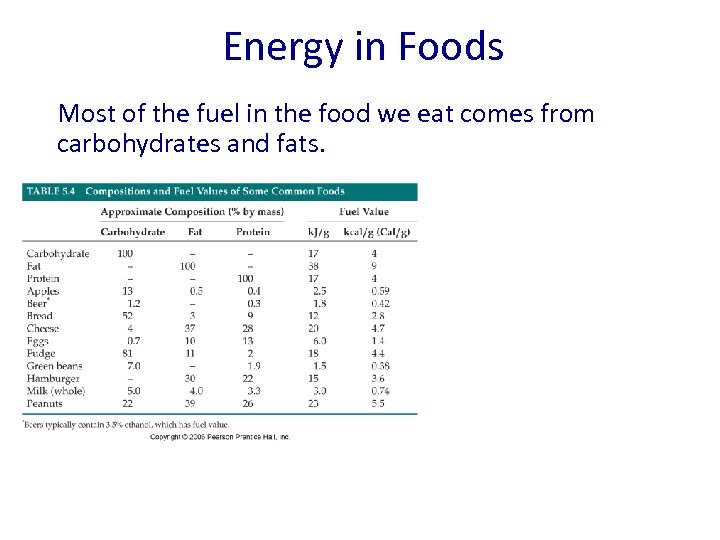 Energy in Foods Most of the fuel in the food we eat comes from carbohydrates and fats.
Energy in Foods Most of the fuel in the food we eat comes from carbohydrates and fats.
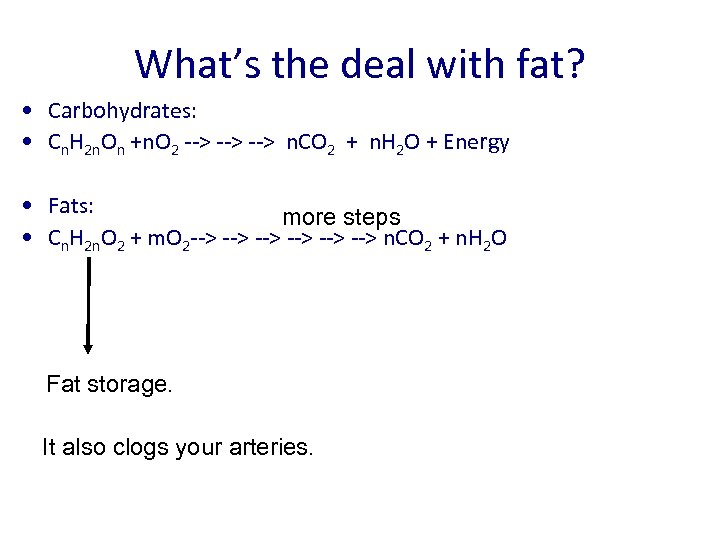 What’s the deal with fat? • Carbohydrates: • Cn. H 2 n. On +n. O 2 --> --> n. CO 2 + n. H 2 O + Energy • Fats: more steps • Cn. H 2 n. O 2 + m. O 2 --> --> --> n. CO 2 + n. H 2 O Fat storage. It also clogs your arteries.
What’s the deal with fat? • Carbohydrates: • Cn. H 2 n. On +n. O 2 --> --> n. CO 2 + n. H 2 O + Energy • Fats: more steps • Cn. H 2 n. O 2 + m. O 2 --> --> --> n. CO 2 + n. H 2 O Fat storage. It also clogs your arteries.
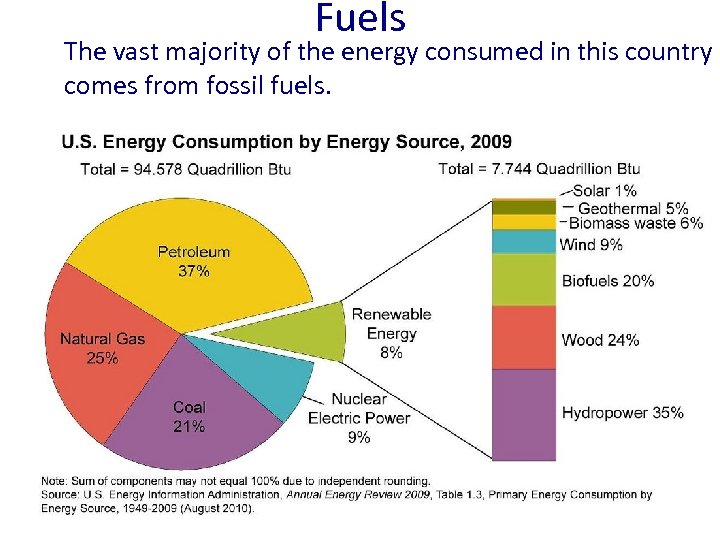 Fuels The vast majority of the energy consumed in this country comes from fossil fuels.
Fuels The vast majority of the energy consumed in this country comes from fossil fuels.
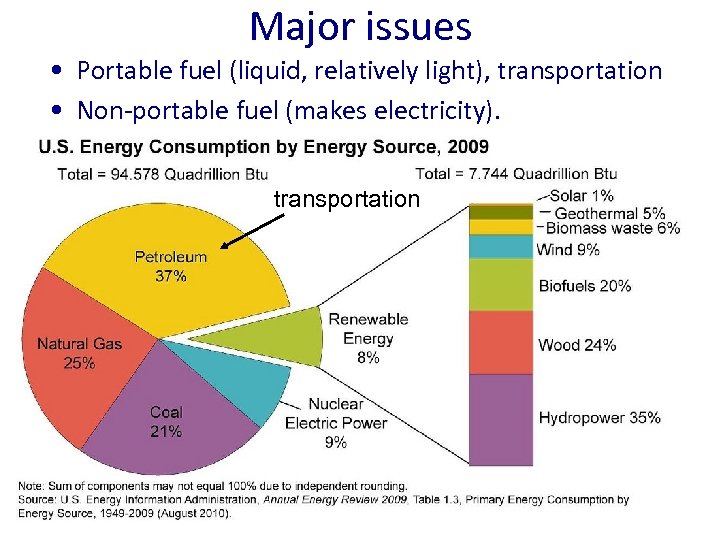 Major issues • Portable fuel (liquid, relatively light), transportation • Non-portable fuel (makes electricity). transportation
Major issues • Portable fuel (liquid, relatively light), transportation • Non-portable fuel (makes electricity). transportation
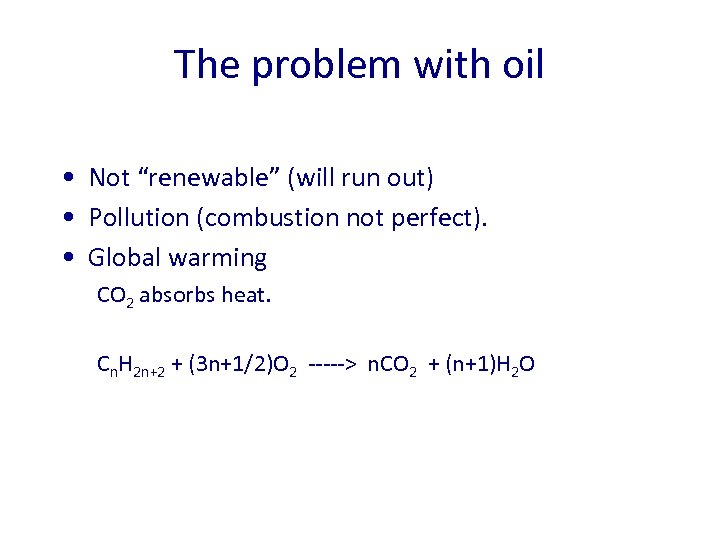 The problem with oil • Not “renewable” (will run out) • Pollution (combustion not perfect). • Global warming CO 2 absorbs heat. Cn. H 2 n+2 + (3 n+1/2)O 2 -----> n. CO 2 + (n+1)H 2 O
The problem with oil • Not “renewable” (will run out) • Pollution (combustion not perfect). • Global warming CO 2 absorbs heat. Cn. H 2 n+2 + (3 n+1/2)O 2 -----> n. CO 2 + (n+1)H 2 O
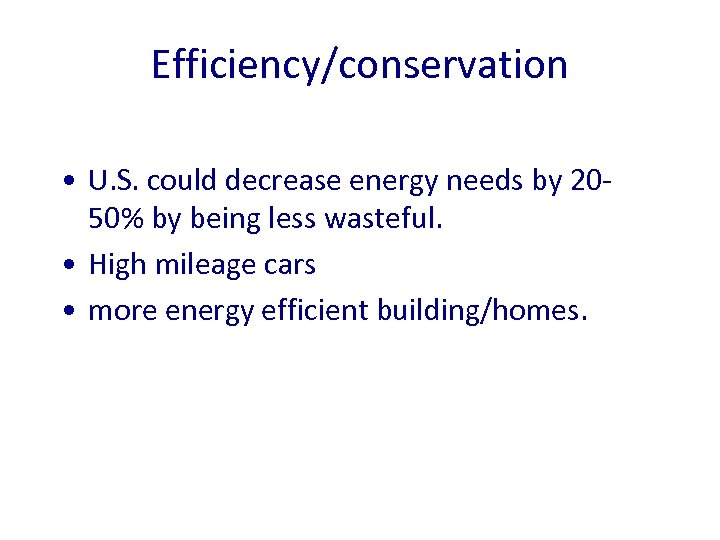 Efficiency/conservation • U. S. could decrease energy needs by 2050% by being less wasteful. • High mileage cars • more energy efficient building/homes.
Efficiency/conservation • U. S. could decrease energy needs by 2050% by being less wasteful. • High mileage cars • more energy efficient building/homes.
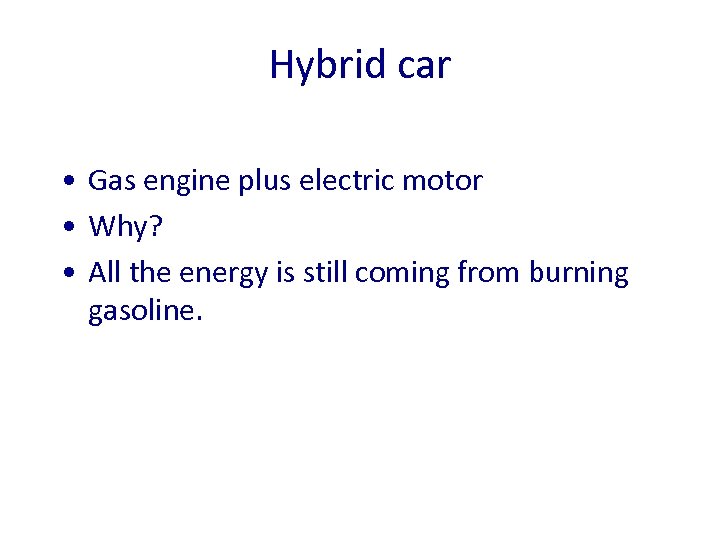 Hybrid car • Gas engine plus electric motor • Why? • All the energy is still coming from burning gasoline.
Hybrid car • Gas engine plus electric motor • Why? • All the energy is still coming from burning gasoline.
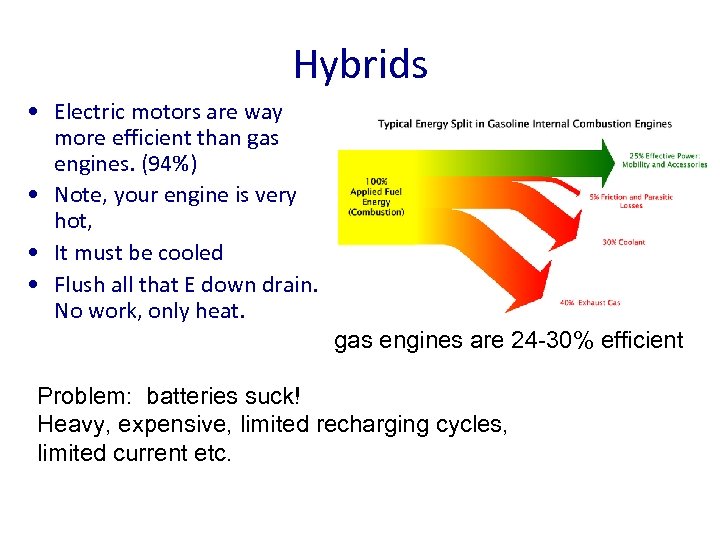 Hybrids • Electric motors are way more efficient than gas engines. (94%) • Note, your engine is very hot, • It must be cooled • Flush all that E down drain. No work, only heat. gas engines are 24 -30% efficient Problem: batteries suck! Heavy, expensive, limited recharging cycles, limited current etc.
Hybrids • Electric motors are way more efficient than gas engines. (94%) • Note, your engine is very hot, • It must be cooled • Flush all that E down drain. No work, only heat. gas engines are 24 -30% efficient Problem: batteries suck! Heavy, expensive, limited recharging cycles, limited current etc.
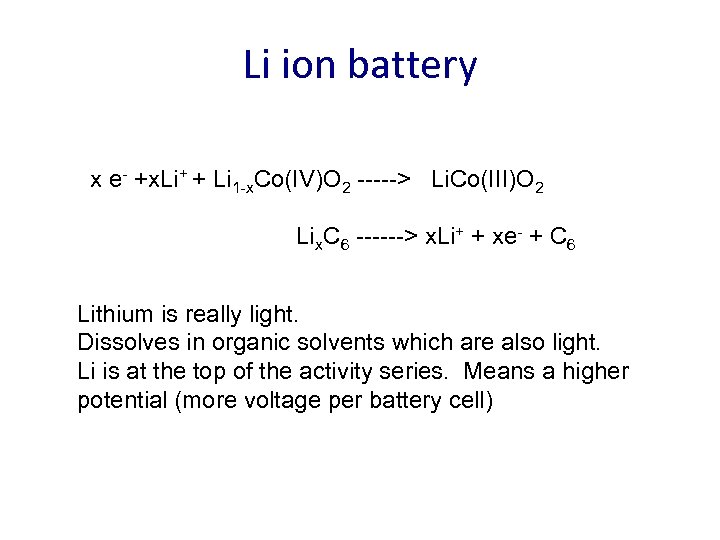 Li ion battery x e- +x. Li+ + Li 1 -x. Co(IV)O 2 -----> Li. Co(III)O 2 Lix. C 6 ------> x. Li+ + xe- + C 6 Lithium is really light. Dissolves in organic solvents which are also light. Li is at the top of the activity series. Means a higher potential (more voltage per battery cell)
Li ion battery x e- +x. Li+ + Li 1 -x. Co(IV)O 2 -----> Li. Co(III)O 2 Lix. C 6 ------> x. Li+ + xe- + C 6 Lithium is really light. Dissolves in organic solvents which are also light. Li is at the top of the activity series. Means a higher potential (more voltage per battery cell)
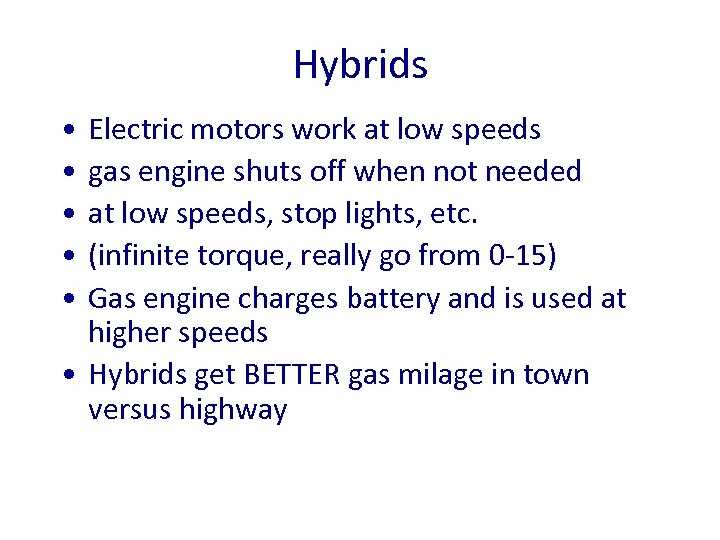 Hybrids • • • Electric motors work at low speeds gas engine shuts off when not needed at low speeds, stop lights, etc. (infinite torque, really go from 0 -15) Gas engine charges battery and is used at higher speeds • Hybrids get BETTER gas milage in town versus highway
Hybrids • • • Electric motors work at low speeds gas engine shuts off when not needed at low speeds, stop lights, etc. (infinite torque, really go from 0 -15) Gas engine charges battery and is used at higher speeds • Hybrids get BETTER gas milage in town versus highway
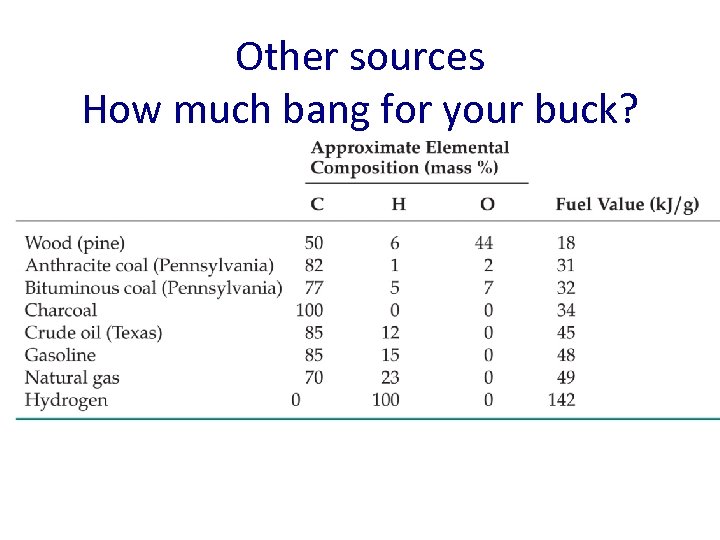 Other sources How much bang for your buck?
Other sources How much bang for your buck?
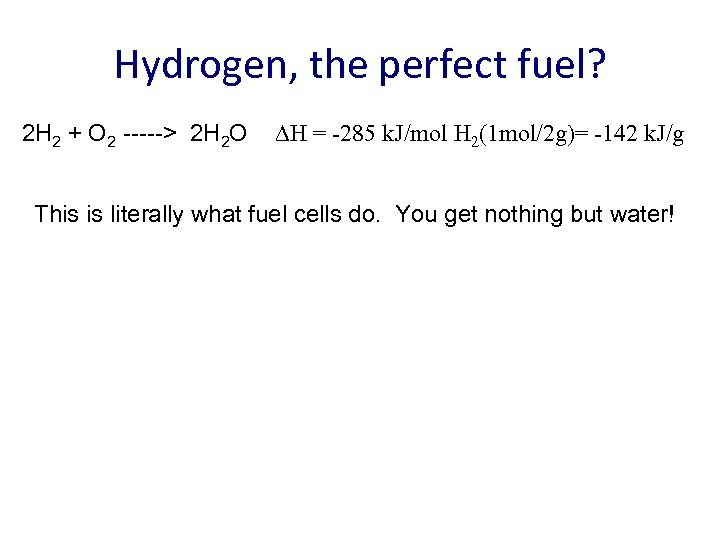 Hydrogen, the perfect fuel? 2 H 2 + O 2 -----> 2 H 2 O H = -285 k. J/mol H 2(1 mol/2 g)= -142 k. J/g This is literally what fuel cells do. You get nothing but water!
Hydrogen, the perfect fuel? 2 H 2 + O 2 -----> 2 H 2 O H = -285 k. J/mol H 2(1 mol/2 g)= -142 k. J/g This is literally what fuel cells do. You get nothing but water!
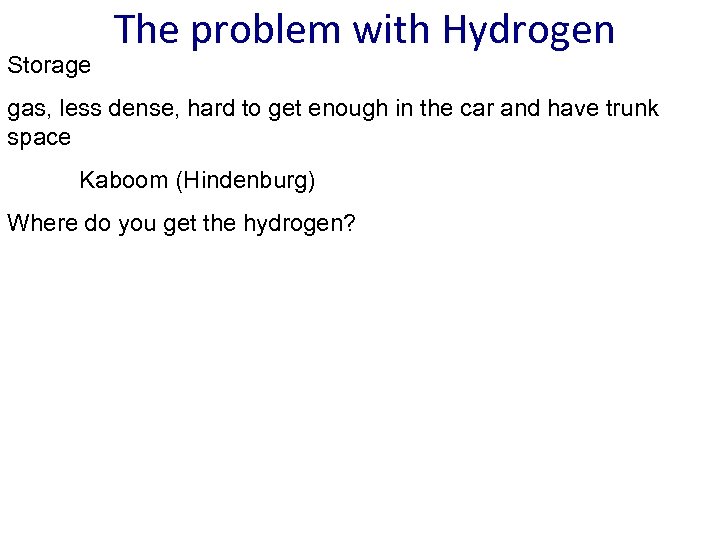 Storage The problem with Hydrogen gas, less dense, hard to get enough in the car and have trunk space Kaboom (Hindenburg) Where do you get the hydrogen?
Storage The problem with Hydrogen gas, less dense, hard to get enough in the car and have trunk space Kaboom (Hindenburg) Where do you get the hydrogen?
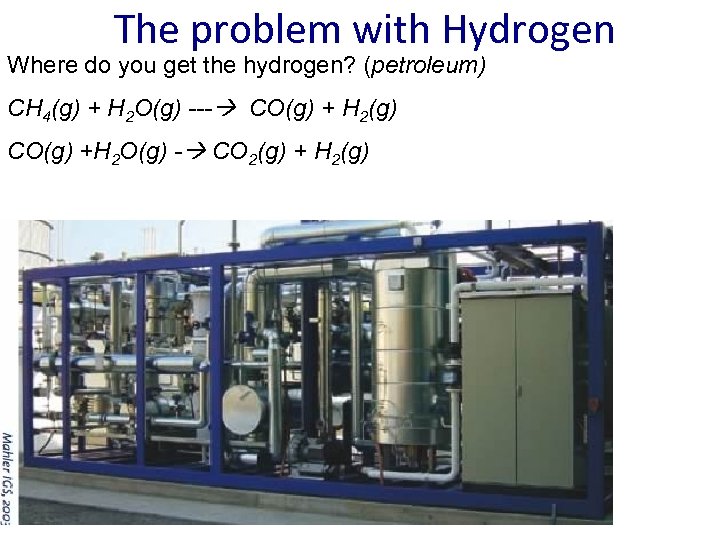 The problem with Hydrogen Where do you get the hydrogen? (petroleum) CH 4(g) + H 2 O(g) --- CO(g) + H 2(g) CO(g) +H 2 O(g) - CO 2(g) + H 2(g)
The problem with Hydrogen Where do you get the hydrogen? (petroleum) CH 4(g) + H 2 O(g) --- CO(g) + H 2(g) CO(g) +H 2 O(g) - CO 2(g) + H 2(g)
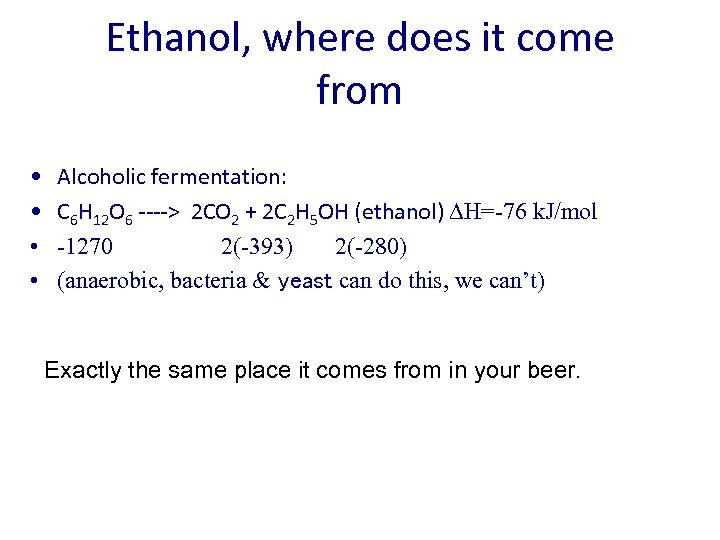 Ethanol, where does it come from • • Alcoholic fermentation: C 6 H 12 O 6 ----> 2 CO 2 + 2 C 2 H 5 OH (ethanol) H=-76 k. J/mol -1270 2(-393) 2(-280) (anaerobic, bacteria & yeast can do this, we can’t) Exactly the same place it comes from in your beer.
Ethanol, where does it come from • • Alcoholic fermentation: C 6 H 12 O 6 ----> 2 CO 2 + 2 C 2 H 5 OH (ethanol) H=-76 k. J/mol -1270 2(-393) 2(-280) (anaerobic, bacteria & yeast can do this, we can’t) Exactly the same place it comes from in your beer.
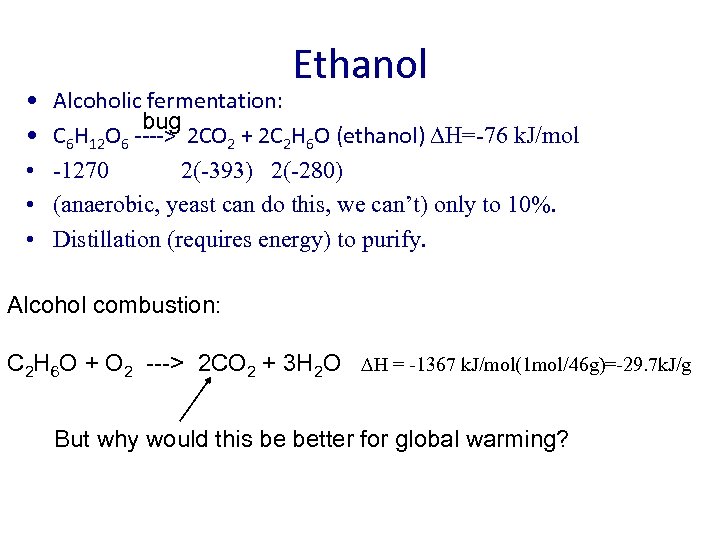 • • • Ethanol Alcoholic fermentation: bug C 6 H 12 O 6 ----> 2 CO 2 + 2 C 2 H 6 O (ethanol) H=-76 k. J/mol -1270 2(-393) 2(-280) (anaerobic, yeast can do this, we can’t) only to 10%. Distillation (requires energy) to purify. Alcohol combustion: C 2 H 6 O + O 2 ---> 2 CO 2 + 3 H 2 O H = -1367 k. J/mol(1 mol/46 g)=-29. 7 k. J/g But why would this be better for global warming?
• • • Ethanol Alcoholic fermentation: bug C 6 H 12 O 6 ----> 2 CO 2 + 2 C 2 H 6 O (ethanol) H=-76 k. J/mol -1270 2(-393) 2(-280) (anaerobic, yeast can do this, we can’t) only to 10%. Distillation (requires energy) to purify. Alcohol combustion: C 2 H 6 O + O 2 ---> 2 CO 2 + 3 H 2 O H = -1367 k. J/mol(1 mol/46 g)=-29. 7 k. J/g But why would this be better for global warming?
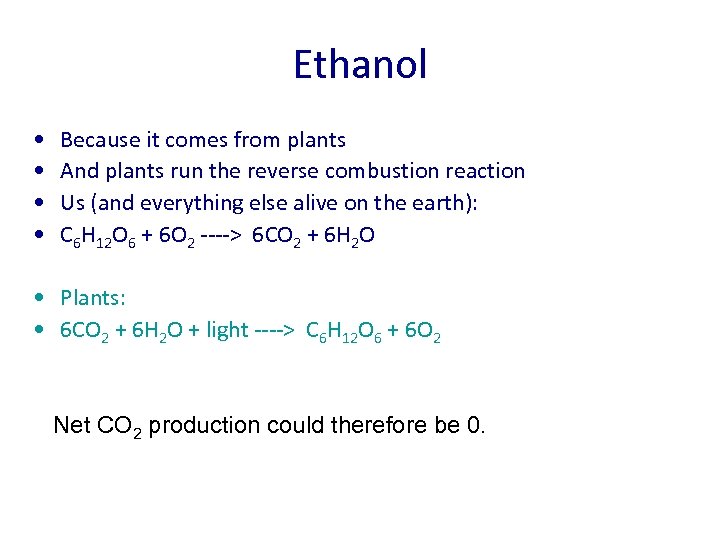 Ethanol • • Because it comes from plants And plants run the reverse combustion reaction Us (and everything else alive on the earth): C 6 H 12 O 6 + 6 O 2 ----> 6 CO 2 + 6 H 2 O • Plants: • 6 CO 2 + 6 H 2 O + light ----> C 6 H 12 O 6 + 6 O 2 Net CO 2 production could therefore be 0.
Ethanol • • Because it comes from plants And plants run the reverse combustion reaction Us (and everything else alive on the earth): C 6 H 12 O 6 + 6 O 2 ----> 6 CO 2 + 6 H 2 O • Plants: • 6 CO 2 + 6 H 2 O + light ----> C 6 H 12 O 6 + 6 O 2 Net CO 2 production could therefore be 0.
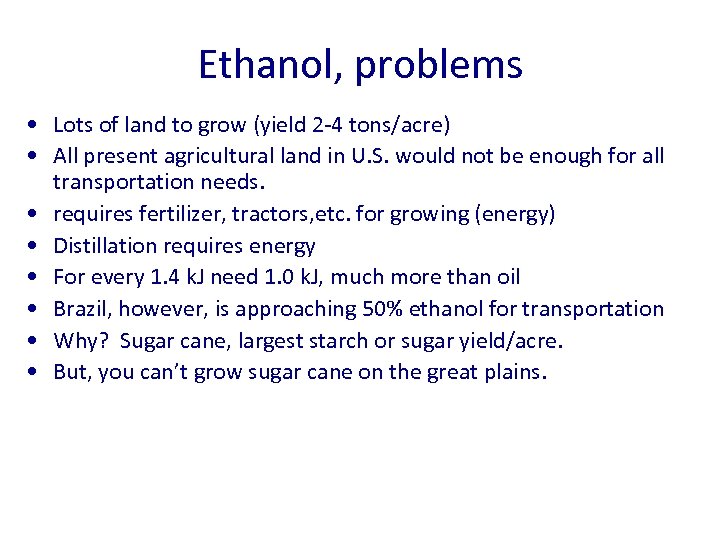 Ethanol, problems • Lots of land to grow (yield 2 -4 tons/acre) • All present agricultural land in U. S. would not be enough for all transportation needs. • requires fertilizer, tractors, etc. for growing (energy) • Distillation requires energy • For every 1. 4 k. J need 1. 0 k. J, much more than oil • Brazil, however, is approaching 50% ethanol for transportation • Why? Sugar cane, largest starch or sugar yield/acre. • But, you can’t grow sugar cane on the great plains.
Ethanol, problems • Lots of land to grow (yield 2 -4 tons/acre) • All present agricultural land in U. S. would not be enough for all transportation needs. • requires fertilizer, tractors, etc. for growing (energy) • Distillation requires energy • For every 1. 4 k. J need 1. 0 k. J, much more than oil • Brazil, however, is approaching 50% ethanol for transportation • Why? Sugar cane, largest starch or sugar yield/acre. • But, you can’t grow sugar cane on the great plains.
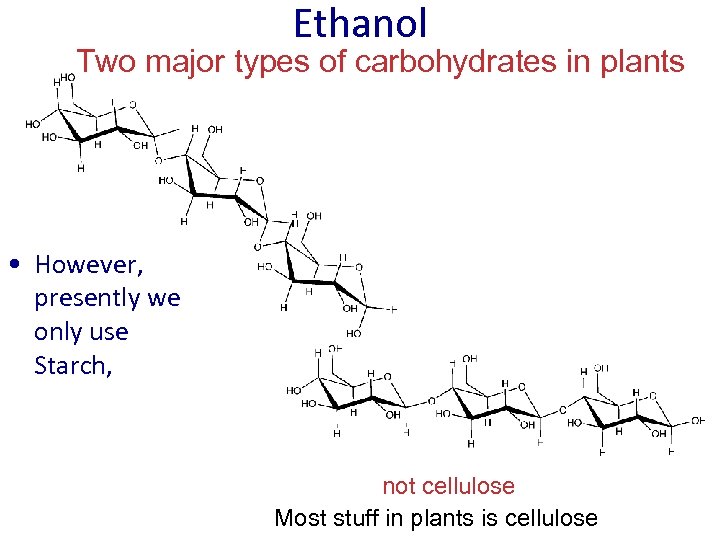 Ethanol Two major types of carbohydrates in plants • However, presently we only use Starch, not cellulose Most stuff in plants is cellulose
Ethanol Two major types of carbohydrates in plants • However, presently we only use Starch, not cellulose Most stuff in plants is cellulose
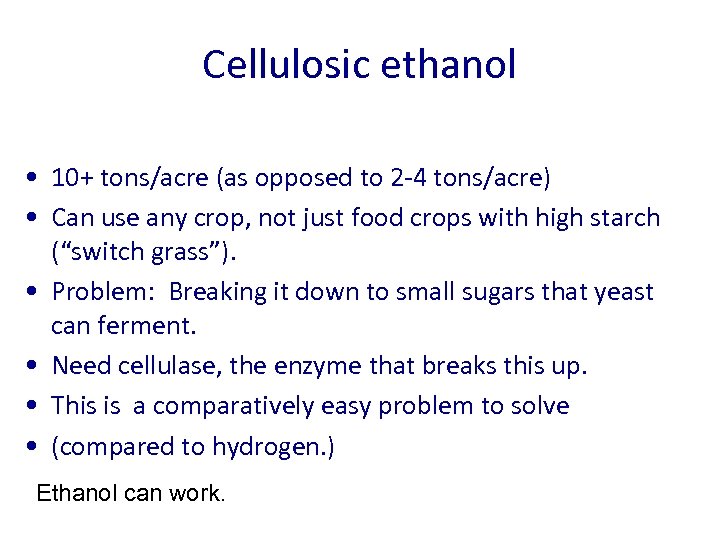 Cellulosic ethanol • 10+ tons/acre (as opposed to 2 -4 tons/acre) • Can use any crop, not just food crops with high starch (“switch grass”). • Problem: Breaking it down to small sugars that yeast can ferment. • Need cellulase, the enzyme that breaks this up. • This is a comparatively easy problem to solve • (compared to hydrogen. ) Ethanol can work.
Cellulosic ethanol • 10+ tons/acre (as opposed to 2 -4 tons/acre) • Can use any crop, not just food crops with high starch (“switch grass”). • Problem: Breaking it down to small sugars that yeast can ferment. • Need cellulase, the enzyme that breaks this up. • This is a comparatively easy problem to solve • (compared to hydrogen. ) Ethanol can work.
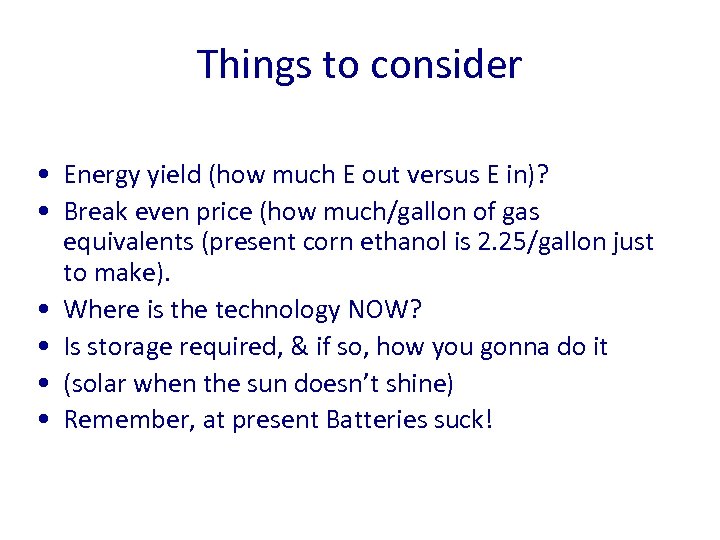 Things to consider • Energy yield (how much E out versus E in)? • Break even price (how much/gallon of gas equivalents (present corn ethanol is 2. 25/gallon just to make). • Where is the technology NOW? • Is storage required, & if so, how you gonna do it • (solar when the sun doesn’t shine) • Remember, at present Batteries suck!
Things to consider • Energy yield (how much E out versus E in)? • Break even price (how much/gallon of gas equivalents (present corn ethanol is 2. 25/gallon just to make). • Where is the technology NOW? • Is storage required, & if so, how you gonna do it • (solar when the sun doesn’t shine) • Remember, at present Batteries suck!

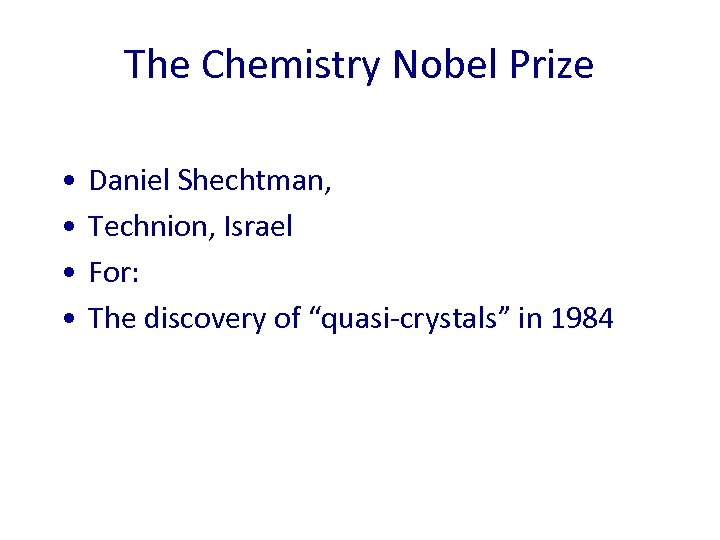 The Chemistry Nobel Prize • • Daniel Shechtman, Technion, Israel For: The discovery of “quasi-crystals” in 1984
The Chemistry Nobel Prize • • Daniel Shechtman, Technion, Israel For: The discovery of “quasi-crystals” in 1984
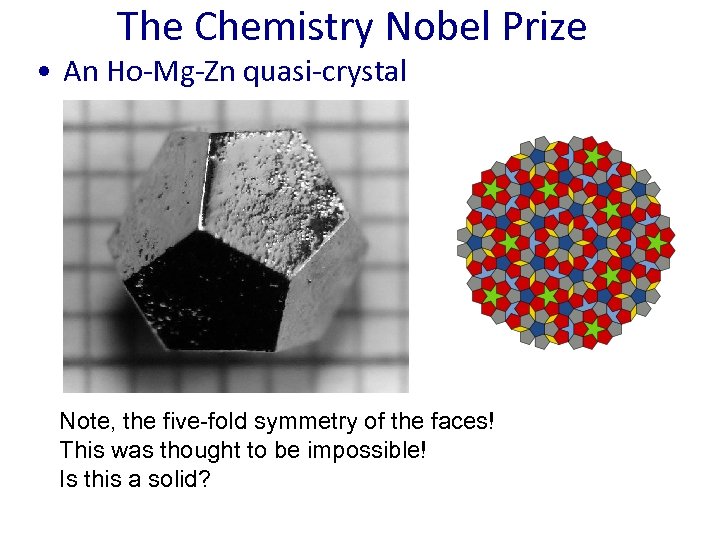 The Chemistry Nobel Prize • An Ho-Mg-Zn quasi-crystal Note, the five-fold symmetry of the faces! This was thought to be impossible! Is this a solid?
The Chemistry Nobel Prize • An Ho-Mg-Zn quasi-crystal Note, the five-fold symmetry of the faces! This was thought to be impossible! Is this a solid?

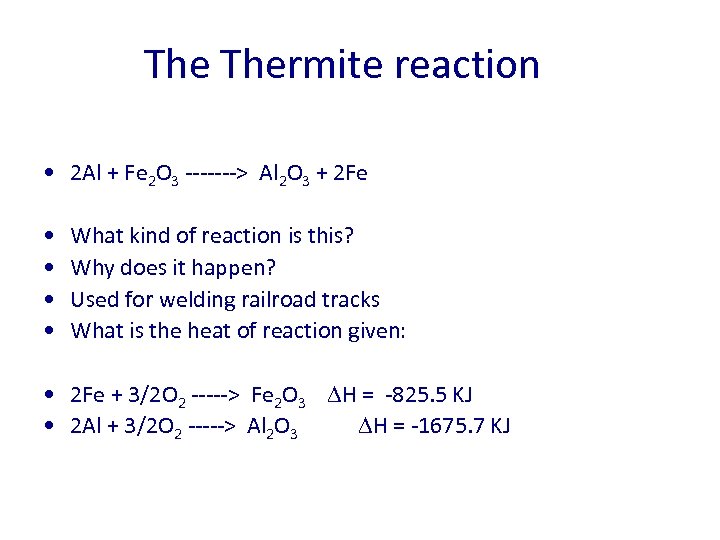 The Thermite reaction • 2 Al + Fe 2 O 3 -------> Al 2 O 3 + 2 Fe • • What kind of reaction is this? Why does it happen? Used for welding railroad tracks What is the heat of reaction given: • 2 Fe + 3/2 O 2 -----> Fe 2 O 3 H = -825. 5 KJ • 2 Al + 3/2 O 2 -----> Al 2 O 3 H = -1675. 7 KJ
The Thermite reaction • 2 Al + Fe 2 O 3 -------> Al 2 O 3 + 2 Fe • • What kind of reaction is this? Why does it happen? Used for welding railroad tracks What is the heat of reaction given: • 2 Fe + 3/2 O 2 -----> Fe 2 O 3 H = -825. 5 KJ • 2 Al + 3/2 O 2 -----> Al 2 O 3 H = -1675. 7 KJ
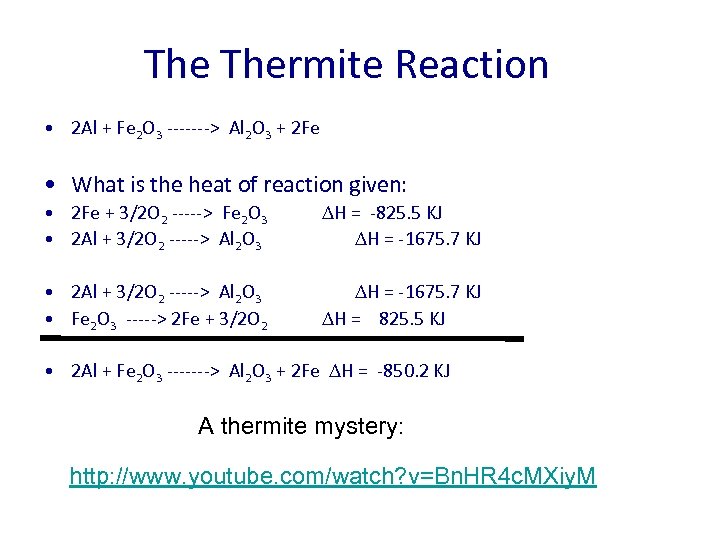 The Thermite Reaction • 2 Al + Fe 2 O 3 -------> Al 2 O 3 + 2 Fe • What is the heat of reaction given: • 2 Fe + 3/2 O 2 -----> Fe 2 O 3 • 2 Al + 3/2 O 2 -----> Al 2 O 3 H = -825. 5 KJ H = -1675. 7 KJ • 2 Al + 3/2 O 2 -----> Al 2 O 3 • Fe 2 O 3 -----> 2 Fe + 3/2 O 2 H = -1675. 7 KJ H = 825. 5 KJ • 2 Al + Fe 2 O 3 -------> Al 2 O 3 + 2 Fe H = -850. 2 KJ A thermite mystery: http: //www. youtube. com/watch? v=Bn. HR 4 c. MXiy. M
The Thermite Reaction • 2 Al + Fe 2 O 3 -------> Al 2 O 3 + 2 Fe • What is the heat of reaction given: • 2 Fe + 3/2 O 2 -----> Fe 2 O 3 • 2 Al + 3/2 O 2 -----> Al 2 O 3 H = -825. 5 KJ H = -1675. 7 KJ • 2 Al + 3/2 O 2 -----> Al 2 O 3 • Fe 2 O 3 -----> 2 Fe + 3/2 O 2 H = -1675. 7 KJ H = 825. 5 KJ • 2 Al + Fe 2 O 3 -------> Al 2 O 3 + 2 Fe H = -850. 2 KJ A thermite mystery: http: //www. youtube. com/watch? v=Bn. HR 4 c. MXiy. M


